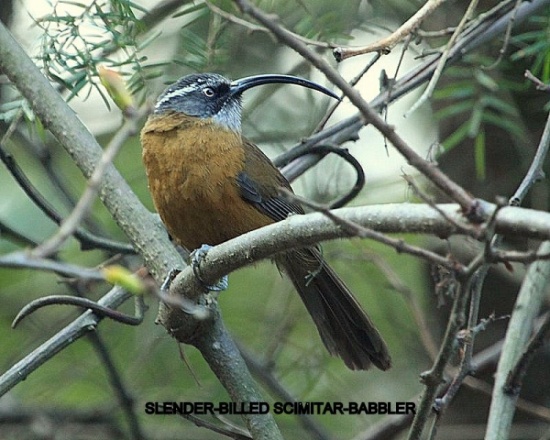Alternative name: Sickle-billed Scimitar-Babbler
- Pomatorhinus superciliaris
Identification
20 cm. An aberrant, small-headed Scimitar-babbler
- Very long narrow, sharply downturned blackish bill
- Dark warm brown above
- Grey head
- Prominent whitish spotted-supercilium
- Grey-streaked whitish throat
- Paler rufous below
Sexes similar. Juveniles like adults but with shorter bill.
Distribution
Found from central Nepal east over Bhutan and northeast India to north and west Burma, adjacent south China (Yunnan) and north Vietnam.
Scarce and uncommon in its range.
Taxonomy
4 subspecies recognized:
- P. s. superciliaris in Nepal and east over Bhutan to northeast India (central Arunachal Pradesh)
- P. s. intextus in northeast India and west and northwest Burma
- P. s. forresti in northeast Burma and south China (Yunnan)
- P. s. rothschildi in north Vietnam
Formerly placed in genus Xiphirhynchus.
Habitat
Bamboo thickets in temperate forest. Found at 1400m to 3500m in the Indian Subcontinent, 915m to 2745m in southeast Asia.
Behaviour
Feeds on beetles, ants and other insects, takes also berries and nectar.
Usually seen in small, noisy and restless groups, sometimes with other babblers. Hunts on ground, feeds mostly in bamboo.
Breeding season from April to July in India. The nest is a large globular structure with an entrance at one end. It's made of dry bamboo, orchid and other leaves and placed on the ground among grass, in a bush or on top of a stump, up to 1m above ground. Lays 3 - 5 eggs.
Resident species with some altitudinal movement recorded in Bhutan and northeast India.
References
- Del Hoyo, J, A Elliott, and D Christie, eds. 2007. Handbook of the Birds of the World. Volume 12: Picathartes to Tits and Chickadees. Barcelona: Lynx Edicions. ISBN 978-8496553422
- Rasmussen, PC and JC Anderton. 2005. Birds of South Asia: The Ripley Guide. Barcelona: Lynx Edicions. ISBN 978-8487334672
- Clements, J. F., T. S. Schulenberg, M. J. Iliff, B.L. Sullivan, C. L. Wood, and D. Roberson. 2013. The eBird/Clements checklist of birds of the world: Version 6.8., with updates to August 2013. Downloaded from http://www.birds.cornell.edu/clementschecklist/download/
Recommended Citation
- BirdForum Opus contributors. (2024) Slender-billed Scimitar Babbler. In: BirdForum, the forum for wild birds and birding. Retrieved 19 April 2024 from https://www.birdforum.net/opus/Slender-billed_Scimitar_Babbler




